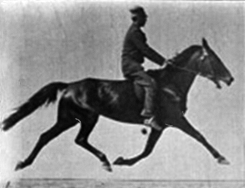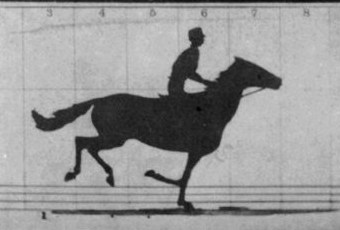This post might not be much of use for the development of an art project, but might be some of the insight on it. As a student at Academy of Fine Arts and Design, I was fascinated with movement or even just a notion of it in the artwork. I remember reading and looking some books then and as studying it making photocopies from them for measurements. There is one book that I liked most – I don't know what was it. But have some copies of horses:
Another book that I like most and it is good for studying animal movements – Manfred Zoller: Gestalt und Anatomie – Ein Leitfaden fur den bildnerischen Weg
and the photo book of Eadweard Muybridge: Horses and Other Animals In Motion.
Eadweard Muybridge: Animated sequence of a Belgian horse walking
Eadweard Muybridge: Animated sequence of a horse pacing
Before comming to The University granted research Muybridge made first experiments today called Sallie Gardner at a Gallop – an upper last appeared sequence which consists of series of photographs consisting of a galloping horse, the result of a photographic experiment on 15. June 1878.
Eadweard Muybridge: The Horse in Motion
Links to Muybridge and horse movement:
https://en.wikipedia.org/wiki/Eadweard_Muybridge
https://en.wikipedia.org/wiki/Horse_gait
And another book on movement and anatomy of horse - I really recomend this for reading:
Sarah Pilliner, Samantha Elmhurst, Zoe Davies: The Horse in Motion: The Anatomy and Physiology of Equine Locomotion
Some thoughts from the book on horse gait. One of the most cultivated animals on the level of movement throughout history is a horse (and a dog). Different movement is classified as horse gaits. Those are various ways in which a horse can move, either naturally or as a result of specialized training by humans. Each gait has a characteristic sequence of footfalls, which determines the number of beats per stride and gives rise to the rhythm of the gait. Tempo is used to describe either the speed of the rhythm or the velocity of the gait. Cadence is used to indicate that a gait combines rhythm with impulsion. Gaits can be described as symmetric or asymmetric. In a symmetric gait right and left sides move in a similar way.
Anatomy of horse – his skeletal structure and muscles are important in the effect of the way the horse moves:
The front legs are attached to the rib-cage by muscles and ligaments, not to a collar bone. Instead, the horse’s body is slung in a cradle of muscle between the two shoulder blades. These muscles allow the horse’s trunk to rise and fall or to lean a little to one side, helping the horse keep its balance, particularly when cornering at speed.
The front legs bear more weight than the hind legs, and hence, there is more concussion involved with the movement.
The head and neck act as a balancing weight.
The muscles which bring the front legs forward are attached to the neck.
The spine has limited sideways and up and down movement between the neck and tail. In practical terms, the trunk is almost rigid, and its role is to transfer the power generated by the hind legs into forward motion.
The hind legs have a bony attachment to the spine for effective transfer of the forces of movement.
Further readings:
George Stubbs: The Anatomy of the Horse
Klaus Dieter Budras, W. O. Sack: Anatomy of the Horse
Lowes Dalbiac Luard: The Anatomy and Action of the Horse








No comments:
Post a Comment